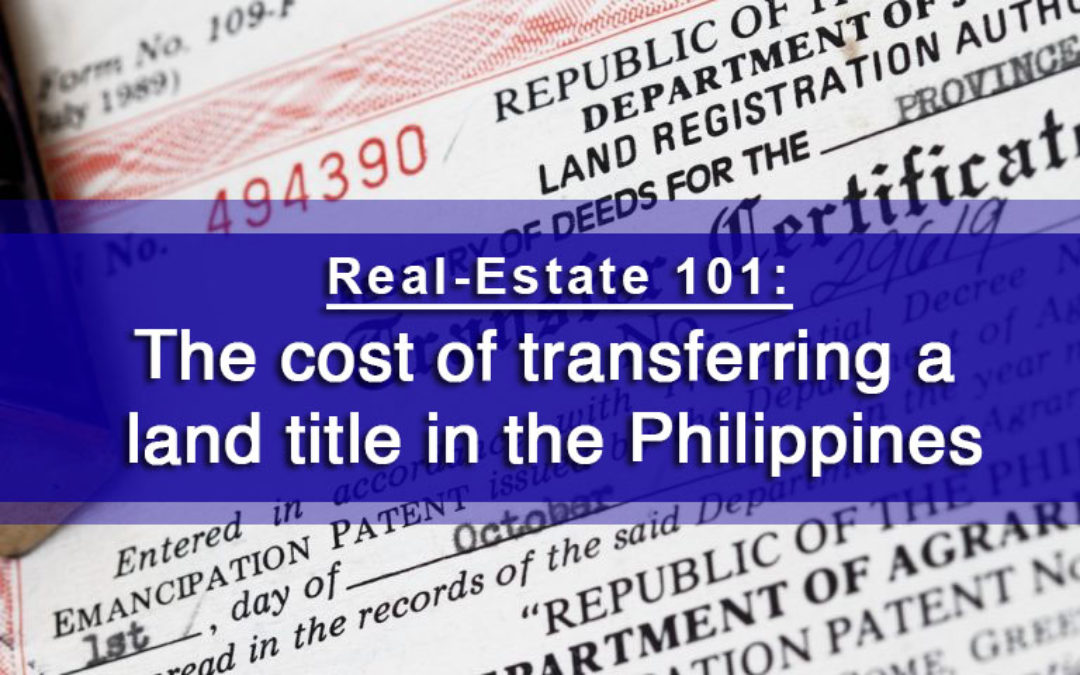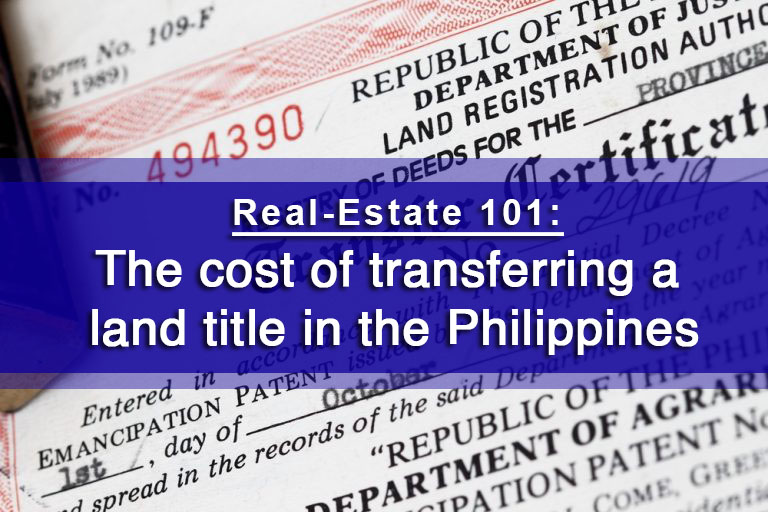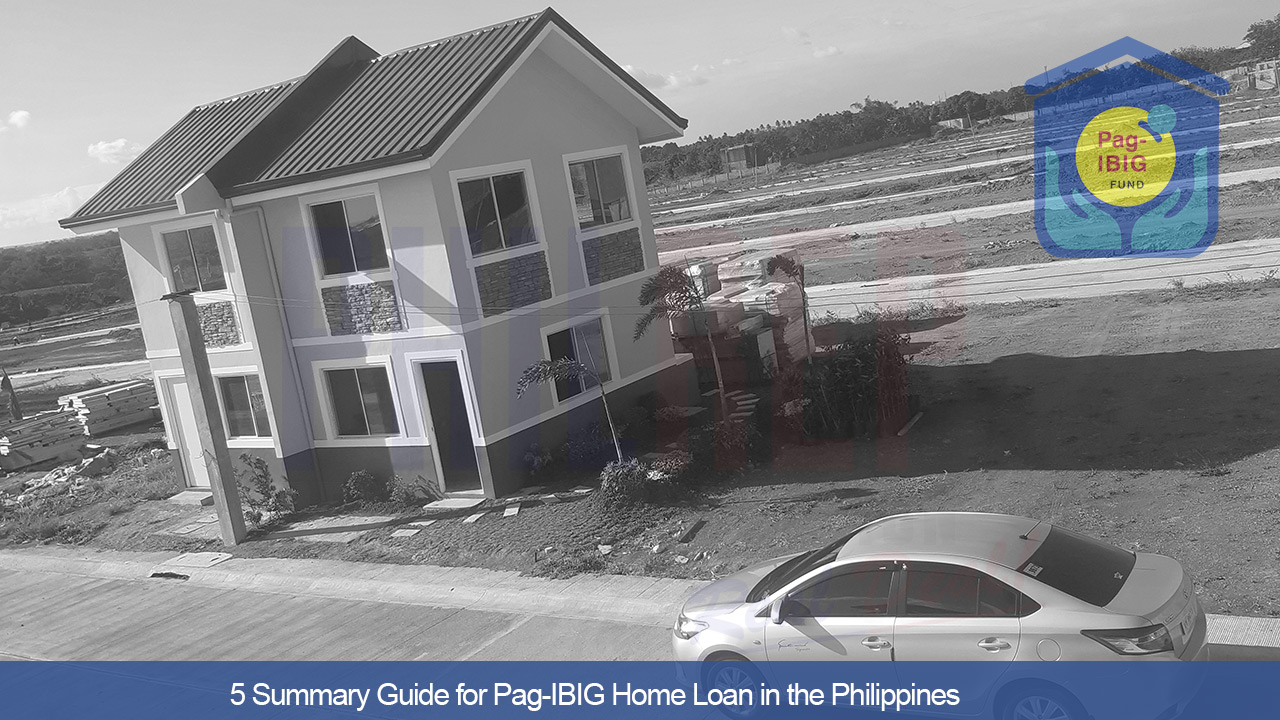
by Doah Sto. Tomas

The cost of transferring a land title in the Philippines
We will be bringing you a series of articles that discuss commonly asked questions regarding real estate in general. One of the most commonly asked questions we encounter whenever we conduct trainings and orientation seminars for those interested to get into the real estate industry is “How much does it cost to transfer the land title”?
Buying property is generally considered one of the biggest steps a person can take in life, typically due to the large amount involved. But unlike other purchases that one can make, real estate is not something you can normally have by paying for in one quick transaction. Along with the property’s price are other expenses that come as part of the purchase. In this respect, the most important is perhaps the cost to transfer the land title.
For buyers or sellers, transferring the land title can prove to be a challenging experience. The paperwork involved and the fees that need to be paid can be daunting for first timers. With that said, let’s start off by discussing the fees associated with purchasing property. Let’s start off with the cost of transferring the land title. This fee needs to be paid whenever property is purchased, sold, donated or inherited. Having the land title under your name is very important as it serves as your proof of ownership of the property, regardless if you are a buyer, a donee or an heir. The absence of this document can lead to the ownership of your property being disputed. Therefore, it is imperative that you ensure the correct processing of this document. And one of the ways to ensure this is to pay all the required fees and taxes.
The following are the fees and taxes that you need to be aware of. The amount of these fees and taxes are based on how much the property cost at the time of the transaction or transfer:
- Any Unpaid Real Estate Taxes due – always check if the property you are buying has any unpaid real estate taxes particularly if you are buying property directly from the owner
- Capital Gains Tax (CGT) – this is computed as 6% of the selling price specified on the Deed of Sale or the Zonal value, whichever amount is higher
- Withholding Tax – this only applies when the seller of the property is a corporation (e.g. a land Developer)
- Transfer Tax (Local Treasurer’s Office) – this is tax imposed on the sale, barter, or any other method of transferring of the ownership or title of real property, at the maximum rate of 50% of 1 percent of a property’s worth (in the case of cities and municipalities within Metro Manila, this is 75% of 1 percent)
- Transfer Tax (BIR) – Transfer taxes may also be owed to the Bureau of Internal Revenue. If the property was donated, the Transfer Tax is in the form of Donor’s Tax. If the property was transferred via inheritance, this is in the form of estate tax.
- Documentary Stamp Tax – this is commonly set at 1.5 percent of the selling price, or the zonal value or fair market value, whichever is higher.
- Registration Fee – commonly set at 0.25 percent of the selling price, or zonal value or fair market value, whichever is higher.
- Commission of the Agent and/or Broker
- Incidental and miscellaneous expenses – typically any expense incurred in the registration process, such as notary fees, etc.
The total amount of all these fees and taxes is the cost of transferring a land title. As you can see, all these fees and taxes can quickly add up.
Now, closely related to this topic is another question often asked immediately afterwards: “Who should shoulder the Land Title Transfer expenses?”
The common practice in the Philippines is that the seller is responsible for the following:
- Capital Gains Tax
- Withholding Taxes
- Any unpaid real estate taxes that are due
- Commission of the Agent and/or Broker assisting in the completion of the transaction
The buyer on the other hand, takes care of the following:
- Documentary Stamps
- Transfer Taxes
- Registration Fees
- Incidentals and miscellaneous expenses incurred in the registration process
This arrangement is considered standard practice. But in other cases, the buyer and seller can also mutually agree on who pays for what during the negotiation period, when the Deed of Sale (a.k.a. Deed of Absolute Sale) has not been signed yet. This document shows the legal transfer of real estate property ownership and is submitted to the Registry of Deeds for filing after the buyer pays the Documentary stamps, transfer tax and registration fees for the aforementioned Land Title Transfer.
As you can see, the entire process and everything involved can prove to be very burdensome to both buyer and seller. Since most buyers are willing to pay millions to buy property, it is sometimes worth it to engage a company that specializes in land title transfers in order to take the burden away from the buyer and seller. This also ensures that the transfer is done correctly and completely.

by Doah Sto. Tomas

With the rise in cybersecurity threats and data breaches, companies have been advising people to turn on multi-factor authentication (MFA). This basically involves using more than one method of authenticating a user.
For example, a website may require you to enter your username and password, then send an SMS message to the mobile phone number you specified during registration. The code in the SMS message is randomly generated hence the term One-Time-Password (OTP). You need to enter the OTP in order for you to gain access to the website.
Likewise, mobile banking apps on your phone also implement MFA by requiring you to enter your username and password, then also send you the OTP (usually on first time access). They also normally require the use of OTP for transaction that involve payments, fund transfers, or any changes to your user account info.
Sounds like a very secure way of doing transactions right? Someone would need to steal your phone (or your SIM) in order to obtain your OTP in order to impersonate you and perform transactions in your name. This is basically a form of IDENTITY THEFT.
Scammers and crooks have always been busy trying to find ways of defeating the latest security measures. The latest wave of identity theft goes by several names. Some call it the SIM swap scam, others call it SIM splitting fraud. But whatever name you prefer to call it, here is some of the common ways the scam is committed:
- Someone claiming to be a Telco representative offers you a SIM upgrade. All you need to do is turn in your old SIM card so they can replace it with a new SIM card with upgraded features. Unless you’re actually at the Telco branch talking to the customer sales representative sitting behind the desk, do not surrender your SIM! The moment you surrender your SIM card, these crooks now have access to your OTP and can start attempting to change your user account information so they can eventually make fraudulent transactions.
- Another way this scam is performed is with the help of someone within the Telco company itself. There have been stories of Telco staff participating (either willingly or unwillingly) to illegally provide duplicate SIM cards to criminals organizations and scammers.
- Some may even go to the Telco branch and claim to be you and report your SIM card as missing and request for a replacement SIM card.
Regardless of the method, the end result can be devastating for you and your family. Your entire life savings or retirement fund can be wiped out should you fall for this scam!
To combat this kind of criminal activity and fraud, the following tips may prove to be a life-saver:
- Needless to say, ALWAYS turn on MFA on all your mobile devices
- If available on your device, use biometric (i.e. fingerprint or facial recognition) authentication
- Regularly change your password (every 90 days is a good interval)
- Always use long complex passwords that only you can remember. If you love eating ice cream, an example of complex password can be “Ic3Cre@mSunda3!”
- If you don’t like remember many passwords, you can use a password manager so that it will take care of generating complex and randomized passwords for each website you visit, and you will only need to remember the master password. Don’t take our word for it, check out this list of recommended password managers: https://tinyurl.com/y7vuowqa
At the end of the day, knowledge about these scams and vigilance on our part will be our weapons against these criminal elements that want to steal your hard-earned money!

by Doah Sto. Tomas

If you are trying to get back on your feet amidst the GCQ, then here are a few ways to get clients in the new normal!
Build A Website
The new normal requires social distancing, and with non-essential businesses temporarily closed due to the government mandate for self-quarantine measures to be in effect, having a website is one of the best ways to get your listings out. We know this can be a bit daunting for most people, so we’ll post more articles to help you get started building your website, so stay tuned! For now, let’s concentrate on the advantages of having your own real-estate website:
1.) Accessibility
Once you have your website up and running, your properties can be viewed by endless potential clients from all over the world. It is readily accessible, and it can be easily shared online. The properties you sell can be seen conveniently and gain interest from various people. But what if getting your website up and running is currently not feasible right now? What other options do you have to get the word out online that you’re in the real-estate business? The next best thing is to leverage something that is already there and already accessed by millions of people worldwide, and that is Social Media! Don’t worry, we’ll get to that in a minute.
2.) Credibility
With a website, you can build your online credibility and even establish your brand, if you’re inclined to do so. Building credibility is very important for Brokers and Agents alike. Having good credibility builds trust with your client and can help you land good deals and in turn, potential get more buyers through positive word-of-mouth.
To establish a good business and personal relationship with your clients, it is advisable that you start focusing on specific projects or areas. Having a focus project or area allows you to concentrate on learning all about that specific project or area. The whole point of this is to become very familiar with the project to the point where you can call yourself a subject matter expert (SME). Being an SME means you can talk about a project in detail with your potential clients and answer their questions with confidence. This builds up your image with your buyers because this shows them that you know exactly what you are talking about.
3.) Management
With your own website, you have complete control over what you post, and when you post it. This means you now have the ability to keep all your listings up to date. An updated inventory gives you the advantage of finding the right home for your client. This can be very advantageous if you are focusing on high-end properties. Depending on the number of properties you advertise, this can be also pose a challenge as well.
Use Social Media
Having your own website out of the question for now? You can use social media as your platform! It’s quick and easy to set up!
1.) Advertisements
Take advantage of the various free social media sites such as Twitter, Facebook, LinkedIn, and Instagram to advertise your listings and garner attention. These platforms are often used by the general public, and when properly utilized, can spread your name or your company’s name in a very short period of time. You also have the option of boosting your posts in social media. On most social media platforms, boosting your post is quite affordable, but your mileage may vary of course. It is always better to build your online reputation first by creating useful and informative posts on these platforms so that people start to take notice of you and hopefully share your posts with their circle of friends and acquaintances. Think of this as a positive word-of-mouth endorsement.
2.) Relevancy
Social media apps are available to almost everyone with Internet access, so it helps you stay relevant in the public’s eye. Using these sites can help you expand your reach in advertising your properties and also get your name out to interested clients. It is important to let your presence be known because the more people that know you, the more they think about your business. Try to keep your posts always relevant to real-estate so that your social media profile because better associated with the real-estate industry.
3.) Branding
If you want to be able to differentiate yourself from the rest of your competitors, you should establish your brand. This is a great way to establish name-recall and show your specialization to your clients. You can brand yourself as a property consultant, but that also makes you responsible for keeping yourself up to date on everything affecting real estate. This means always reading the latest news and trends from reputable sources. Doing this gives your clients the confidence that they are getting the best advice on their real estate concerns.
Learn Video/Photo Editing and Production
You need to be competitive online. It is inevitable that you need to learn and understand what makes a video or picture effective in attracting potential buyers. It’s a given that potential clients will want to see what you’re selling. After all, everyone wants to see what they’re paying for!
1.) Visual Appeal
It is important for listings to be appealing to clients. It either creates a good or bad impression on them. Often buyers tend to not stick around a property which looks dark, cluttered, and unorganized. It also shows how the quality of the estate, whether the condition is fit for them to live in or not. It pays to learn more about the basics of taking an appealing photo of real-estate properties. We will tackle this in future articles.
2.) Perspective
Basic knowledge on selecting a good visual perspective of a property will help make your property more appealing to potential clients. It will also help make your listing more visually informative, providing your buyer with a better understanding of the estate.
3.) Image and Video size
This is a bit on the technical side, but you want to keep the file size of your images and videos small enough so they load quickly but still retain a decent visual quality so they don’t come out as blurry or pixelated. We will be posting more on this topic soon, so stay tuned for our future articles!
Knowledge on Your Property
1.) Be Knowledgeable
This is very important in the field of Real Estate. The last person a buyer wants to talk to is someone who doesn’t have the basic information readily available. Having extensive knowledge on the property you are selling can help clients make decisions faster (i.e. close the sale). Also, being able to answer their questions quickly and effectively shows your seriousness in helping them make an informed decision. You might now end up closing the deal now, but this will leave a positive impression on your client and can potentially result in a future sale or referral.
2.) Customer Care
It is important to assume that you are not the only one a buyer is talking with. Most clients shop around first in order to compare offers from properties that they are interested in. Potential clients often go for the agent or broker who provides the best knowledge and customer care. Show the customer you are not just in it for the commission, but you are providing them a valuable service by acting as an investment adviser of sorts so they can make the best decision with their money.
3.) Landing the Deal
If you have great familiarity and knowledge on your properties, you can cater to your buyer’s needs effectively. You can also provide alternatives or better options to fit their tastes when looking through listings, thus helping them find their dream home or investment opportunity.
“Dahil sa new normal, kailangan natin gumawa ng paraan para maka-adapt sa ating bagong sitwasyon. Wala sa edad ‘yan, lahat tayo puede matuto, basta palagi natin isipin na kakayanin natin.”

by Doah Sto. Tomas

Mortgage Redemption Insurance or MRI is a type of Life Insurance required by Banks and other Lending Institutions when you apply for a Home Loan. An MRI pays off the outstanding mortgage balance of the borrower in case of his or her death or total disability.
While there are those who do not see the need for an MRI, as it supposedly just adds to the money that needs to be shelled out. The purpose of an MRI is two-fold: First, it protects the bank – the MRI guarantees that the bank will be paid back the amount that was lent out. Therefore, the bank or lender does not have to sequester the house from the borrower’s surviving family. Secondly, it protects the borrower’s surviving family – the MRI helps settle the outstanding house loan amount so that the borrower’s surviving family does not have to worry about how to pay off the outstanding loan amount.
Whenever you make a significant investment, you need to protect it via insurance. To be clear, MRI is not like fire insurance which is typically an add-on to your property insurance, or insurance that includes protection from Acts-of-God. Hopefully, You now have a better understanding of MRI and how it is different from fire insurance.
Should you have any other real-estate related questions, please feel free to comment or email your questions to broker.doah@philrep.com.ph

by MikeL Reonal

Every Filipino has a dream of owning a house of there dream and as part of the benefits of becoming a Pag-IBIG member is the privilege of home financing. We here at Philrep Realty Corp. is committed to guiding you from start to finish in buying your dream home. We want to help you understand the process of dealing with the application smooth and less hassle. See this summary guide on where and how you can start applying for your Pag-IBIG home loan.
- Before we start, let’s check out first the requirements.
- Have made at least 24 monthly savings. The lump-sum payment of the required 24 monthly savings is allowed.
- Not more than 65 yrs. old, and not more than 70 yrs. old at maturity of the date of the loan application.
- Have the legal capacity to acquire and encumber real property.
- Have passed satisfactory background/credit and employment/business checks of Pag-IBIG Fund.
- Have no outstanding Pag-IBIG Fund Short-Term Laon (STL) in arrears at the time of loan application.
- Have no Pag-IBIG Fund housing loan that was foreclosed, canceled, bought back due to default, or subjected to dacion en pago.
(Dacion en pago is a Spanish term that means the giving back of the property mortgaged to the lender in exchange for the discharge of a mortgage debt.)
- Click Here for Requirement Checklist or Pag-IBIG Checklist Note: Better to complete first all the requirements before submitting.
- Schedule an appointment through Online Housing Loan Application (OHLA) Click Here
Note: A special lane in Pag-IBIG Fund branch offices is available for those who made an online schedule. They will be given priority over walk-in applications. But you can still apply over the counter if you like, you can file your housing loan application personally at Servicing Department, 2/F JELP Business Solutions, 409 Shaw Blvd. Mandaluyong City, or at any Pag-IBIG Fund brand office.
- After submitting all the documents required. Wait for your approval – Pag-IBIG will notify you within 17 days
- If approved, you will receive the Notice of Approval (NOA) and Letter of Guaranty (LOG)
- Sign your loan documents and complete other documents needed for check release
- Claim your check.
- Start paying your monthly amortization.










